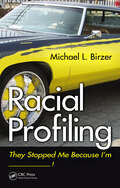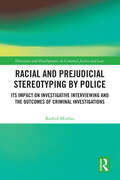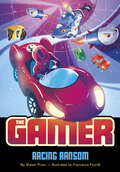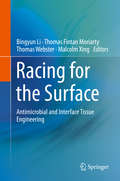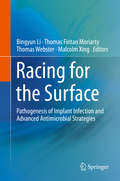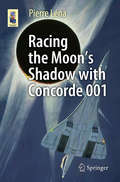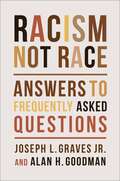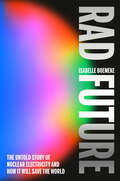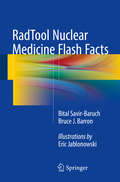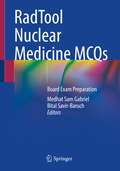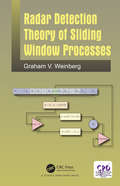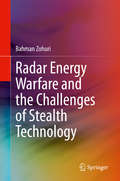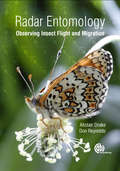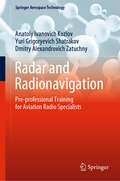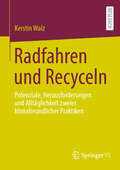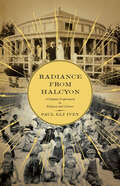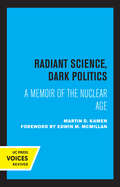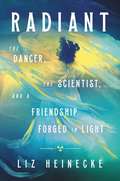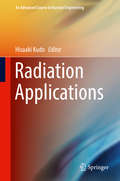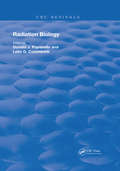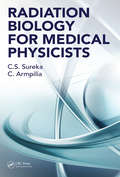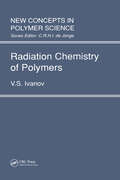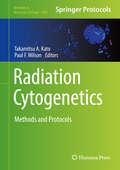- Table View
- List View
Racial Profiling: They Stopped Me Because I'm ------------!
by Michael L. BirzerMany racial minority communities claim profiling occurs frequently in their neighborhoods. Police authorities, for the most part, deny that they engage in racially biased police tactics. A handful of books have been published on the topic, but they tend to offer only anecdotal reports offering little reliable insight. Few use a qualitative methodol
Racial and Prejudicial Stereotyping by Police: Its Impact on Investigative Interviewing and the Outcomes of Criminal Investigations (ISSN)
by Rashid MinhasThis book uncovers the influence of racial and prejudicial stereotyping during police investigation of suspects from stigmatised communities. The book examines the under-researched aspect of whether and how negative stereotypes appear to influence the police interviews, investigative decision-making, and outcomes of criminal investigations when officers investigate individuals from stigmatised communities as suspects of crime.In the United Kingdom, the United States, and Europe, the war on terror has been argued to impact adversely on existing race relations policies in the aftermath of terrorist activity in both the United States and Europe. Recent research has suggested that changes in legislation and counterterrorism measures have contributed to the construction and reinforcement of the Muslim community as a suspect, which, in turn, may result in police bias and prejudice towards members of Muslim communities. Based on novel and groundbreaking research studies, the author examines whether such police bias could influence the police investigation and interviewing processes concerning individuals from the suspect community as well as the outcome of a criminal investigation.The author introduces the Minhas Investigative Interviewing Prejudicial Stereotyping Scale (MIIPSS), an instrument developed and used to assess the level of police interviewers’ racial and prejudicial stereotyping towards suspects from stigmatised groups, and maintains that its use would serve to minimise the influence of racial and prejudicial stereotypes on investigation. It is further suggested that the training of police officers on the implications of such prejudicial (racial/ religious) stereotyping is essential to improving interviewing performance, case outcomes, and community cohesion.This book will benefit academics, researchers, police officers, lawyers, social policy officers, and probation officers across the globe.
Racing Ransom (The Gamer)
by Shawn PryorThe race is on for the Gamer! Villain Cynthia Cyber has captured two victims in her video game Space Racers. The helpless players cannot escape their speeding cars. Even worse, a monster racer is threatening to destroy them. The Gamer must drive on to the digital track and rescue the racers before it’s game over.
Racing for the Surface: Antimicrobial and Interface Tissue Engineering
by Bingyun Li Thomas Webster Thomas Fintan Moriarty Malcolm XingThis book covers the key basics of tissue engineering as well as the latest advances in the integration of both antimicrobial and osteoinductive properties. Topics covered include osteoconductive and osteoinductive biomaterials (calcium phosphate, bone morphogenetic protein, peptides, antibodies, bioactive glasses, nanomaterials, etc.) and scaffolds. Research integrating both antimicrobial/biofilm-inhibiting and osteoinductive/osteoconductive properties and their co-delivery is detailed and their roles in clinical success are discussed. Combined with its companion volume, Racing for the Surface: Antimicrobial and Interface Tissue Engineering, this book bridges the gap between infection and tissue engineering, and is an ideal book for academic researchers, clinicians, industrial engineers and scientists, governmental representatives in national laboratories, and advanced undergraduate students and post-doctoral fellows who are interested in tissue engineering and regeneration, infection, and biomaterials and devices.
Racing for the Surface: Pathogenesis of Implant Infection and Advanced Antimicrobial Strategies
by Bingyun Li Thomas Webster Thomas Fintan Moriarty Malcolm XingThis book covers the latest research in biofilm, infection, and antimicrobial strategies in reducing and treating musculoskeletal, skin, transfusion, implant-related infections, etc. Topics covered include biofilms, small colony variants, antimicrobial biomaterials (antibiotics, antimicrobial peptides, hydrogels, bioinspired interfaces, immunotherapeutic approaches, and more), antimicrobial coatings, engineering and 3D printing, antimicrobial delivery vehicles, and perspectives on clinical impacts. Antibiotic resistance, which shifts the race toward bacteria, and strategies to reduce antibiotic resistance, are also briefly touched on. Combined with its companion volume, Racing for the Surface: Pathogenesis of Implant Infection and Advanced Antimicrobial Strategies, this book bridges the gaps between infection and tissue engineering, and is an ideal book for academic researchers, clinicians, industrial engineers and scientists, governmental representatives in national laboratories, and advanced undergraduate students and post-doctoral fellows who are interested in infection, microbiology, and biomaterials and devices.
Racing the Moon's Shadow with Concorde 001
by Pierre LénaThis is the unique story of observing a total solar eclipse for no less than 74 consecutive minutes. On the summer morning of June 30, 1973, the Sun rises on the Canary Islands. But it is strangely indented by the Moon. The eclipse of the century has just begun. From the west, the lunar shadow rushes to the African coast at a velocity of over 2000 kilometers per hour. Astronomers on the ground will enjoy seven short minutes of total eclipse to study the solar corona - too short for Pierre Lena and seven scientists who board the Concorde 001 prototype, an extraordinary plane to become the first commercial supersonic aircraft. With André Turcat as chief pilot and a crew of five, at 17000 m altitude, the aircraft remains in the lunar shadow for 74 minutes, a record time of scientific observations not yet beaten and allowing for exceptional measurements. Science, technology, aviation and history combine in the story of a unique human adventure aboard a legendary aircraft, illustrated with a rich and original iconography. It reflects the wonderful domains that science and technology can open, and the passion in the professions they offer. A must read for every eclipse chaser and fan of true scientific adventures. On the summer morning of June 30, 1973, the Sun rises on the Canary Islands. But it is strangely indented by the Moon. The eclipse of the century has just begun. From the west, the lunar shadow rushes to the African coast at a velocity of over 2000 kilometers per hour. Astronomers on the ground will enjoy seven short minutes of total eclipse to study the solar corona - too short for Pierre Lena and seven scientists who board the Concorde 001 prototype, an extraordinary plane to become the first commercial supersonic aircraft. With André Turcat as chief pilot and a crew of five, at 17000 m altitude, the aircraft remains in the lunar shadow for 74 minutes, a record time of scientific observations not yet beaten and allowing for exceptional measurements. Science, technology, aviation and history combine in the story of a unique human adventure aboard a legendary aircraft, illustrated with a rich and original iconography. It reflects the wonderful domains that science and technology can open, and the passion in the professions they offer. A must read for every eclipse chaser and fan of true scientific adventures.
Racism, Not Race: Answers to Frequently Asked Questions
by Alan H. Goodman Joseph L. Graves Jr.The science on race is clear. Common categories like “Black,” “white,” and “Asian” do not represent genetic differences among groups. But if race is a pernicious fiction according to natural science, it is all too significant in the day-to-day lives of racialized people across the globe. Inequities in health, wealth, and an array of other life outcomes cannot be explained without referring to “race”—but their true source is racism. What do we need to know about the pseudoscience of race in order to fight racism and fulfill human potential?In this book, two distinguished scientists tackle common misconceptions about race, human biology, and racism. Using an accessible question-and-answer format, Joseph L. Graves Jr. and Alan H. Goodman explain the differences between social and biological notions of race. Although there are many meaningful human genetic variations, they do not map onto socially constructed racial categories. Drawing on evidence from both natural and social science, Graves and Goodman dismantle the malignant myth of gene-based racial difference. They demonstrate that the ideology of racism created races and show why the inequalities ascribed to race are in fact caused by racism.Graves and Goodman provide persuasive and timely answers to key questions about race and racism for a moment when people of all backgrounds are striving for social justice. Racism, Not Race shows readers why antiracist principles are both just and backed by sound science.
Rad Future: The Untold Story of Nuclear Electricity and How It Will Save the World
by Isabelle BoemekeWe&’re running out of time. Fossil fuels are choking the planet and renewable energy isn&’t cutting it. The solution has been hiding in plain sight all along.Nuclear.When most people hear that word, they go to a very bad place: bombs, Chernobyl, hazmat suits, radioactive fallout… the stuff of nightmares. But what if everything you think you know about nuclear is wrong?In Rad Future, science influencer Isabelle Boemeke shatters the fear and misinformation surrounding this technology and shows how the actual science tells a different story. It turns out that nuclear-generated electricity—nuclear electricity—is our best option for ensuring the future of the planet. Nuclear can power cities, desalinate water, create carbon-free fertilizer, and heat homes, all with the smallest environmental footprint of any energy source.Boemeke exposes how decades of fearmongering, a few dramatic (but preventable) disasters, and relentless bad PR have convinced the world that nuclear is dangerous when it&’s actually the key to an affordable, sustainable future. We&’ve fumbled the bag on the cleanest, most powerful energy source we have, and it&’s time to fix that.This isn&’t your typical science book. Boemeke&’s signature mix of humor, sass, and deep research makes Rad Future a wild ride through the science, history, and future of nuclear electricity. From Cold War politics to Hollywood-fueled paranoia to cutting-edge reactor designs, she details exactly how nuclear works and why it&’s our best shot at ending the climate crisis and creating a future of radical abundance. Rad Future is the first truly accessible breakdown of nuclear electricity, and it will leave you feeling stoked about what&’s possible.
RadTool Nuclear Medicine Flash Facts
by Bital Savir-Baruch Bruce J. BarronThis book is a learning aid and reference tool that provides all the important information pertaining to radioactive tracers within a single, easy-to-read volume. It introduces a new learning methodology that will help the reader to recall key facts on each tracer, including production, physical and chemical characteristics, study protocols, mechanism of action, distribution, and clearance. In addition, normal and abnormal tracer distributions are graphically reproduced on an outline of the human body using multiple colors. The book will be of value for all radiologists and medical students seeking a reliable source of essential information on radioactive tracers that can be readily consulted during everyday practice and used in preparation for examinations.
RadTool Nuclear Medicine MCQs: Board Exam Preparation
by Bital Savir-Baruch Medhat Sam GabrielThis book, in MCQ format, is a comprehensive tool that will help Nuclear Medicine and Radiology residents and attending physicians to understand concepts in nuclear medicine. Questions cover clinical applications of nuclear medicine techniques to the cardiovascular, pulmonary, endocrine, skeletal, gastrointestinal, genitourinary, and central nervous systems. In addition, topics in physics, radiopharmacy, and radiation safety are addressed. The MCQ format closely resembles that used in board examinations in nuclear medicine. Each question has four possible answers, only one of which is correct. About 60% of the questions are linked to clinical cases, with each case having four questions on average, along with one or two images. The remainder of the questions are free-standing, with or without an image. Answers are concise but are supported by references to the literature when necessary. Pearls in boxes are used to highlight the most important pieces of information. While the questions are scrambled, as in board exams, an index categorizes each question into one of the systems or topics.
Radar Detection Theory of Sliding Window Processes
by Graham WeinbergConstant false alarm rate detection processes are important in radar signal processing. Such detection strategies are used as an alternative to optimal Neyman-Pearson based decision rules, since they can be implemented as a sliding window process running on a radar range-Doppler map. This book examines the development of such detectors in a modern framework. With a particular focus on high resolution X-band maritime surveillance radar, recent approaches are outlined and examined. Performance is assessed when the detectors are run in real X-band radar clutter. The book introduces relevant mathematical tools to allow the reader to understand the development, and follow its implementation.
Radar Energy Warfare and the Challenges of Stealth Technology
by Bahman ZohuriThis book provides a solid foundation for understanding radar energy warfare and stealth technology. The book covers the fundamentals of radar before moving on to more advanced topics, including electronic counter and electronic counter-counter measures, radar absorbing materials, radar cross section, and the science of stealth technology. A final section provides an introduction to Luneberg lens reflectors. The book will provide scientists, engineers, and students with valuable guidance on the fundamentals needed to understand state-of-the-art radar energy warfare and stealth technology research and applications.
Radar Entomology
by Don Reynolds Alistair DrakeMany of the world's most serious agricultural pests are highly migratory. Through the use of special-purpose radars we are provided with insights into their movement and how they learn about and navigate through their environment. This text examines the behaviour and regional variations of these species, as well as the altitude of migration, concentration of insects in layers and how they respond to large and small-scale wind systems. The book relates radar observation of insect movement to complementary and competing methodologies and surveys its capabilities and limitations. It also deals with the applications of these findings in the management and forecasting of both pest and beneficial insects, and is an essential reference for those working in agricultural entomology and pest management.
Radar Meteorology: Principles and Practice.
by Frédéric FabryThis practical textbook introduces the fundamental physics behind radar measurements, to guide students and practitioners in the proper interpretation of radar reflectivity, Doppler velocity and dual-polarization imagery. Operational applications are explored, such as how radar imagery can be used to analyze and forecast convective and widespread weather systems. The book concludes with an overview of current research topics, including the study of clouds and precipitation using radars, signal processing, and data assimilation. Numerous full-color illustrations are included, as well as problem sets, case studies, and a variety of supplementary electronic material including animated time sequences of images to help convey complex concepts. This book is a valuable resource for advanced undergraduate and graduate students in radar meteorology and other related courses, such as precipitation microphysics and dynamics. It will also make a useful reference for researchers, professional meteorologists and hydrologists. Provides a broad introduction to radar meteorology from its physical principles to its applications in research and weather forecasting Electronic supplements include exercises and data sets to test the acquired knowledge, together with additional animated material, showcasing both weather events and radar measurements, to help convey complex concepts. Produced in full color, it includes illuminating imagery to aid visualization and interpretation. A valuable resource for students pursuing an operational or research career that requires extensive use of radar imagery for meteorological purposes.
Radar Networks
by Hai DengRadar networks are increasingly regarded as an efficient approach to enhancing radar capabilities in the face of popular anti-radar techniques and hostile operating environments. Reader-friendly and self-contained, this book provides a comprehensive overview of the latest radar networking technologies. The text addresses basic, relevant aspects of radar signal processing and statistical theories, including both civilian and military radar applications. It also discusses emerging topics that directly relate to networks, such as multiple-input–multiple-output (MIMO) radars, waveform design, and diversity via multiple transmitters. Other topics covered include target recognition and imaging using radar networks. Features Gives a comprehensive view of the latest radar network technologies Covers both civilian and military applications of radar Provides basic statistics and signal processing necessary for understanding radar networks Includes up-to-date information on MIMO radars Presents waveform design and diversity for radar networks with multiple transmitters
Radar and Radionavigation: Pre-professional Training for Aviation Radio Specialists (Springer Aerospace Technology)
by Dmitry Alexandrovich Zatuchny Anatoly Ivanovich Kozlov Yuri Grigoryevich ShatrakovThis book highlights the capabilities and limitations of radar and air navigation. It discusses issues related to the physical principles of an electromagnetic field, the structure of radar information, and ways to transmit it. Attention is paid to the classification of radio waves used for transmitting radar information, as well as to the physical description of their propagation media. The third part of the book addresses issues related to the current state of navigation systems used in civil aviation and the prospects for their development in the future, as well as the history of satellite radio navigation systems. The book may be useful for schoolchildren, interested in the problems of radar and air navigation.
Radfahren und Recyceln: Potenziale, Herausforderungen und Alltäglichkeit zweier klimafreundlicher Praktiken
by Kerstin WalzUm den Ursachen der Klimakrise zu begegnen und deren Auswirkungen substanziell abzuschwächen, ist es eine zentrale Herausforderung, die derzeit verbreiteten ressourcenintensiven Alltagswelten zu transformieren und klimafreundliches Verhalten zur neuen Normalität werden zu lassen. Dieses Buch nimmt hierfür exemplarisch zwei klimafreundliche Alltagsroutinen der Mobilitätswende und Ressourcenwende in den Blick: das Radfahren und das Recyceln. Anhand qualitativer Interviews wird nachgezeichnet, was es in der Praxis bedeutet, in den derzeitigen infrastrukturellen und sozialen Settings mit dem Rad unterwegs zu sein und die alltäglich anfallenden Abfälle zu recyceln, welche Kompetenzen und Erfahrungen erforderlich sind und welche Ansatzpunkte für die weitere Verbreitung vielversprechend erscheinen. Übergreifend werden fünf Ansätze für die Förderung und ein tiefergreifendes Verständnis klimafreundlicher Alltagsnormalitäten abgeleitet.
Radiance from Halcyon: A Utopian Experiment in Religion and Science
by Paul Eli IveyIn May 1904, the residents of Halcyon—a small utopian community on California&’s central coast—invited their neighbors to attend the grand opening of the Halcyon Hotel and Sanatorium. As part of the entertainment, guests were encouraged to have their hands X-rayed. For the founders and members of Halcyon, the X-ray was a demonstration of mysterious spiritual forces made practical to human beings. Radiance from Halcyon is the story not only of the community but also of its uniquely inventive members&’ contributions to religion and science. The new synthesis of religion and science attempted by Theosophy laid the foundation for advances produced by the children of the founding members, including microwave technology and atomic spectral analysis. Paul Eli Ivey&’s narrative starts in the 1890s in Syracuse, New York, with the rising of the Temple of the People, a splinter group of the theosophical movement. After developing its ideals for an agricultural and artisanal community, the Temple purchased land in California and in 1903 began to live its dream there. In addition to an intriguing account of how a little-known utopian religious community profoundly influenced modern science, Ivey offers a wide-ranging cultural history, encompassing Theosophy, novel healing modalities, esoteric architecture, Native American concepts of community, socialist utopias, and innovative modern music.
Radiant Science, Dark Politics: A Memoir of the Nuclear Age
by Martin D. KamenThis title is part of UC Press's Voices Revived program, which commemorates University of California Press’s mission to seek out and cultivate the brightest minds and give them voice, reach, and impact. Drawing on a backlist dating to 1893, Voices Revived makes high-quality, peer-reviewed scholarship accessible once again using print-on-demand technology. This title was originally published in 1985.
Radiant: The Dancer, The Scientist, and a Friendship Forged in Light
by Liz HeineckePart hidden history, part love letter to creative innovation, this is the true story of an unlikely friendship between a dancer, Loie Fuller, and a scientist, Marie Curie, brought together by an illuminating discovery. At the turn of the century, Paris was a hotbed of creativity. Technology boomed, delivering to the world electric light, the automobile, and new ways to treat disease, while imagination blossomed, creating Art Nouveau, motion pictures, and modernist literature. A pivotal figure during this time, yet largely forgotten today, Loie Fuller was an American performance artist who became a living symbol of the Art Nouveau movement with her hypnotic dances and stunning theatrical effects. Credited today as the pioneer of modern dance, she was perennially broke, never took no for an answer, spent most of her life with a female partner, and never questioned her drive. She was a visionary, a renegade, and a loyal friend. In the early 1900s, she heard about Marie Curie's discovery of a glowing blue element and dreamed of using it to dazzle audiences on stage. While Loie's dream wouldn't be realized, her connection with Marie and their shared fascination with radium endured. Radiant is the true story of Marie Curie and Loie Fuller, two revolutionary women drawn together at the dawn of a new era by a singular discovery, and the lifelong friendship that grew out of their shared passion for enlightenment.
Radiation Applications (An\advanced Course In Nuclear Engineering Ser. #07)
by Hisaaki KudoThis book focuses on radiation applications in various fields such as industry, environmental conservation, analytical sciences, agriculture, medical diagnosis and therapy, and other areas, from laboratory or research scale to practical or commercial scale. The book targets rather beginning or young professionals in radiation chemistry, processing, biology, and medicine, among others, but also introduces the state of the art of the relevant fields. This volume also helps readers to understand the fundamentals of radiation chemistry, physics, and biology that underlie the miscellaneous applications. Readers will understand, for example, that industry utilizes radiation to fabricate water-absorbent materials or semiconductors and also that cancer patients can be cured through radiation without surgery. These and more facts about radiation applications are made available in this valuable book.
Radiation Biology (Routledge Revivals)
by Donald J. Pizzarello and Lelio G. ColombettiFirst Published in 1991, this book offers a full, comprehensive guide into the aspects of radiation and how it affects our bodies. Carefully compiled and filled with a vast repertoire of notes, diagrams, and references this book serves as a useful reference for Students of Radiology, and other practitioners in their respective fields.
Radiation Biology for Medical Physicists
by Christina Armpilia C. S. SurekaThis book is designed to convey as much information as possible in a concise and simple way to make it suitable for students, researchers and clinical medical physicists. Better meanings, codes and examples are included. Most of the basics are also covered for easy reference along with a glossary of objective-type questions. Upon completion of this textbook, the readers will gather knowledge about the physics, chemistry and biology of the human body towards cancer treatment using radiation.
Radiation Chemistry of Polymers
by V.S. IvanovPart of the series "New Concepts in Polymer Science", this volume contains information on the main theoretical and practical problems involved in radiation chemistry of polymers. The processes of polymerization and modification of polymers by grafting, crosslinking and degradation, induced by ionizing radiation, are all described, as well as the radiation resistance of polymers and their protection from radiation. The book also contains applications of radiation chemistry of polymers, such as: principles of selection of radiation-chemical processes for industrial use; choice of radiation sources for specific processes; modification of textile and film materials by grafting; manufacturing of heat-shrinkable, thermostable and mechanically strong polymer products; composites; rubber vulcanizates and self-adhesive products; paints and coatings; man-made fibres; materials for microelectronics; and polymer materials for medical purposes.
Radiation Cytogenetics: Methods and Protocols (Methods in Molecular Biology #1984)
by Paul F. Wilson Takamitsu A. KatoThis book comprises a collection of chapters describing topics from traditional radiation cytogenetic analysis methods to the modern fluorescence based-analysis and high throughput automatic analysis methods. Cytogenetic analysis is important not only in order to understand radiation-induced DNA damage in cells, but it is also a standard biological method to estimate human radiation exposure in the radiation accidents. Therefore, we prepared a series of chapters not only covering biological aspects but also exploring radiation physics and radiation protection. Written for the highly successful Methods in Molecular Biology series, chapters include introductions to their respective topics, lists of the necessary materials and equipment, step-by-step, readily reproducible laboratory protocols, and tips on troubleshooting and avoiding known pitfalls. Authoritative and practical, Radiation Cytogenetics: Methods and Protocols serves both novices working on their first experiments as well as experienced researchers searching for tried-and-true techniques to adapt for their own laboratory.
